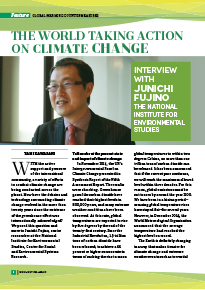Home > Highlighting JAPAN >Highlighting Japan February 2015>Global warming countermeasures
Highlighting JAPAN

The World Taking Action on Climate Change
Interview with Junichi Fujino
The National Institute for Environmental Studies

With the active support and pressure of the international community, a variety of efforts to combat climate change are being conducted across the planet. How have the debates and technology surrounding climate change evolved in the more than twenty years since the existence of the greenhouse effect was internationally acknowledged? We posed this question and more to Junichi Fujino, senior researcher at the National Institute for Environmental Studies, Center for Social and Environmental Systems Research.
![]()
Tell us about the present state and impact of climate change.
In November 2014, the UN’s Intergovernmental Panel on Climate Change presented its Synthesis Report of the Fifth Assessment Report. The results were shocking. Greenhouse gases like carbon dioxide have reached their highest levels in 800,000 years, and many extreme weather conditions have been observed. At this rate, global temperatures are expected to rise by five degrees by the end of the twenty-first century. Since the Industrial Revolution, 1.9 trillion tons of carbon dioxide have been released; to achieve a 66 percent or higher success rate in terms of curbing the rise in mean global temperatures to within two degrees Celsius, no more than one trillion tons of carbon dioxide can be released. It has been announced that if the current pace continues, we will reach the maximum allowed level within three decades. For this reason, global emissions must be cut to zero by around the year 2100. We have been in a hiatus period—meaning global temperature rises have stayed flat—for several years. However, in December 2014, the World Meteorological Organization announced that the average temperature had reached the highest level on record.
The Earth is definitely changing in a way that makes it easier for climate change and extreme weather events such as torrential rains, heat waves and cold waves to occur. Climate change has a profound impact on human health and the ecosystem, including the secondary disasters that occur due to insufficient preparedness for the primary ones. Even in urban planning, for example, it could be said that we’re at the stage where we should be taking climate change as given.
What sorts of measures are the world and Japan in particular taking to combat climate change?
Concern for the environment is on the rise. Even developing countries, which are beginning to deal with prevailing environmental issues caused by their rising lifestyle needs, have launched initiatives to address problems of water, air quality and soil, as well as adopting measures to build environmentally friendly cities. Developed nations are drawing on their past experience to create advanced technology—among them Japan’s is at the cutting edge.
We’re currently developing energy-efficient and renewable energy technologies with the goal to cut greenhouse gas emissions to zero by 2100. Of particular note is the fact that we are seriously looking into a technology that captures and disposes of carbon dioxide emissions as waste material and injects liquefied carbon dioxide into excavated petroleum wells and cracks in geologically stable bedrock. On the other hand, there’s also an approach which makes use of psychosociology, behavioral economics and the analysis of big data, so that social structures can be built to encourage the conservation of energy and proactive actions that are environmentally friendly.
Where should Japan’s focus be in the future?
Japan is a leader in that it has already experienced and overcome severe environmental challenges, and we have advanced technology, but we still are not able to create a sustainable socioeconomic vision after we hit upon the economic model that worked for us in the past.
Regionally, the seeds of building a sustainable society can be found in initiatives launched to support an aging society and spur regional activity—initiatives that have popularized energy-efficient residential housing, for example, or the construction of light rail transit systems that serve as the core of urban areas, encouraging the smart planning of residential districts. Furthermore, by cooperating with our fast-developing neighbors in Asia, we are seeing signs of the creation of sustainable socioeconomic systems.
Solving global environmental issues must begin by raising awareness of the environment around us. We must value and protect the natural resources with which we are blessed locally, and we must use and recycle them efficiently. Japan must create a balanced vision for our future—achieving real reductions in greenhouse gas output, taking a proactive leadership role in addressing environmental issues, and serving as an example to the international community.
© 2009 Cabinet Office, Government of Japan






